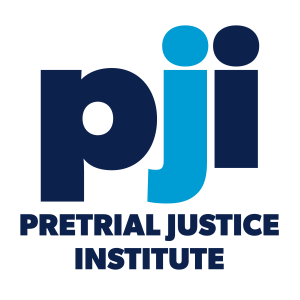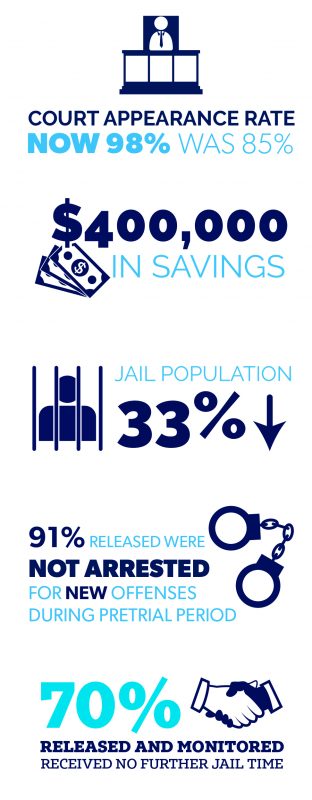 In a perfect world, every state would support local jurisdictions in providing pretrial assessments that help courts make better decisions and maximizing release with minimal intrusion (which is both the legal standard and best practice). In the real world, however, creative local officials sometimes have to take matters into their own hands. That’s what my friend Michael Merican did when he was warden of the jail facility in St. Mary’s County, Maryland. This report—which we provide as inspiration to others—offers a glimpse into why and how he did it. It also documents the remarkable results. The challenges associated with achieving real pretrial justice can sometimes seem daunting. The solutions, however, may be closer than you think.
In a perfect world, every state would support local jurisdictions in providing pretrial assessments that help courts make better decisions and maximizing release with minimal intrusion (which is both the legal standard and best practice). In the real world, however, creative local officials sometimes have to take matters into their own hands. That’s what my friend Michael Merican did when he was warden of the jail facility in St. Mary’s County, Maryland. This report—which we provide as inspiration to others—offers a glimpse into why and how he did it. It also documents the remarkable results. The challenges associated with achieving real pretrial justice can sometimes seem daunting. The solutions, however, may be closer than you think.
– Cherise Fanno Burdeen
CEO, Pretrial Justice Institute

Major Michael R. Merican
Assistant Sheriff
St. Mary’s County Sheriff’s Office
One of the ways local jurisdictions and states can meet the demands of providing safe, fair, and effective pretrial justice is by offering pretrial services. A variety of settings within a county government can provide the structure and personnel needed to do this work, which typically includes preparing pretrial risk assessments on arrested individuals, presenting release recommendations to the court, and supervising some of the people who have been released.
In some states local jurisdictions are obligated by statute to operate such a service. However, many jurisdictions are choosing to move away from money bond on their own with constrained resources and limited stakeholder buy-in. They are seeking creative solutions in the belief that their efforts can more than recover any expenditures they may require.
St. Mary’s County, Maryland, is an example of a local jurisdiction that applied existing resources to offer pretrial services that have resulted in both improved outcomes and saved money.
This brief highlights the efforts of St. Mary’s County, Maryland, where Major Michael Merican, then warden of the St. Mary’s County Detention Center, successfully led the implementation of the St. Mary’s Pretrial Screening and Supervision program in 2015.
 BACKGROUND
BACKGROUND
St. Mary’s County is a predominantly rural area 45 minutes from Washington, DC, with a population of 110,000. When then-Captain Merican became warden of the county detention center, its 230-bed jail was over capacity, with an average daily population around 370 people. After plans to build another jail—at a projected cost of $30 million—stalled, Merican and his staff developed a plan to create their own pretrial services program, with the primary goal of safely and fairly managing the jail population.
STEPS TO BUILDING A PRETRIAL SERVICES PROGRAM
Every locale or jurisdiction will approach the implementation of the key elements of pretrial justice—risk assessment and management—differently, depending on its unique circumstances and needs. The St. Mary’s experience suggests, however, that there are some common steps that local officials can take to get started and adequately support improved practice.
Build Buy-In: Merican first worked to create buy-in from other key justice system members, including judges, prosecutors, law enforcement, probation, parole, and defenders. He found his most persuasive argument focused on the potential to improve public safety rates—specifically, he showed that pretrial services can improve monitoring of released individuals and also lower rearrests. Some stakeholders, including judges, were hungry for such an alternative to incarceration.
It was also important to note the potential benefit to the community. Arrested individuals who are released under pretrial services can have continued access to a variety community services for mental health and substance use, employment, education, and homelessness. In contrast, those who remain incarcerated before trial may lose access to these resources or be placed on long waiting lists.
“Our jail population are some of the biggest users of community services,” says Merican. “With pretrial services, [released] participants can be monitored and put on treatment before they go back to court, instead of detoxing in jail for 48 hours and then having nowhere to go. Pretrial services is a preventive strike.”
In St. Mary’s County, two detention center floor officers were reassigned to serve as case managers of pretrial services. Both had college degrees, as required by state regulations, and one had a degree in substance abuse counseling. Their reassignment did not impact overall jail operations.
“Pick the right people,” advises Merican. “They have to believe in rehabilitation and community supervision.”
He also incorporated a risk assessment instrument developed in nearby Montgomery County (which, while more populous, has a similar crime rate per capita) that he could use at no cost because it did not have a copyright. While a risk assessment instrument ideally should be locally validated, this was his best option for something that could work within his county since it was in use already in Maryland.
The two case managers use the risk assessment instrument to screen individuals who cannot afford bail and present their recommendations to the courts, which have discretion to approve, modify, or deny the recommendations as they see fit. The recommendations can range from release on recognizance with only a reminder to return to court, to more intensive conditions, such as regular check-ins or curfew orders.
The total annual costs for the additional services, which include a supervisor for the two case managers and paying for GPS and drug testing, is approximately $290,000.
Create Pathways to Success: As a corollary to relieving the population pressures within the jail, Merican sought to give released individuals the best chance of pretrial success. For example, he chose to cover the costs of any GPS monitoring or drug testing ordered as conditions of release, rather than pass these expenses along to released individuals. After all, many in the program have very limited income and requiring them to pay for supervision conditions would likely set them up to fail.
On a daily basis, the supervision costs amount to $29 per person in the community compared to $146 per person in detention. “Even when I cover those costs,” says Merican, “community supervision is one-fifth the cost of detention.”
Recognize Logistical Obstacles: As in most other jurisdictions, many of the individuals who are released under the St. Mary’s Pretrial Screening and Supervision program find it difficult to meet release conditions that conflict with their work schedules or that require significant transportation. Recognizing that eliminating these hurdles would increase participants’ chances of success, Merican saw to it that drug testing facilities in St. Mary’s County remain open until 11 p.m., making it easier for participants to submit to regular testing. The program also realizes savings by enrolling participants in health insurance through the Affordable Care Act, which provides drug treatment for those who need it.
Measure and Monitor: Merican’s efforts have shown success. Since the services went into effect in November 2015, participants have had a 98% court appearance rate (compared to an 85% appearance rate prior to the new program), and 91% of released participants were not arrested for new offenses during the pretrial period (comparable pre-program data are not available, but this rate is similar to other jurisdictions using evidence-based practices). Additionally, 70% of people released and monitored through the program received no further jail time.
Over its first year in operation, the St. Mary’s Pretrial Screening and Supervision program contributed to a 33% reduction in the average daily jail population and produced a net day bed savings of nearly $400,000.
“There’s a major change going around the U.S., as we can no longer afford to build bigger jails and prisons, with our jurisdiction being a case in point,” Merican says. “If you’re already running a jail with community supervision, you can get a pretrial services program started.”
Visit http://www.pretrial.org/ for more information
Additional resources:
Join the University of Pretrial for more information and to learn more about St. Mary’s experience in our Smart Pretrial online program, Local Leaders Roundtable. It’s free! https://university.pretrial.org/home
Pretrial Services Program Implementation: A Starter Kit. Report. Pretrial Justice Institute. (2010).
Treatment Improvement Protocol (TIP) Series, No. 44. Center for Substance Abuse Treatment. Rockville (MD): Substance Abuse and Mental Health Services Administration (US). 2005.


